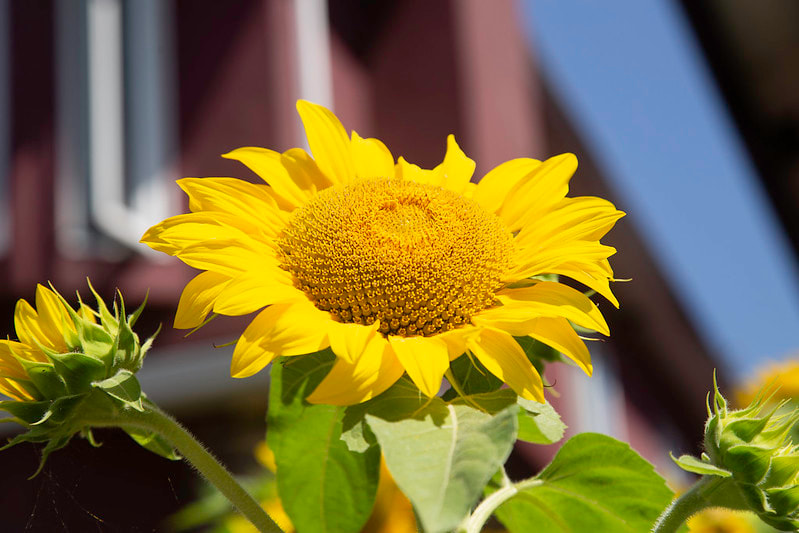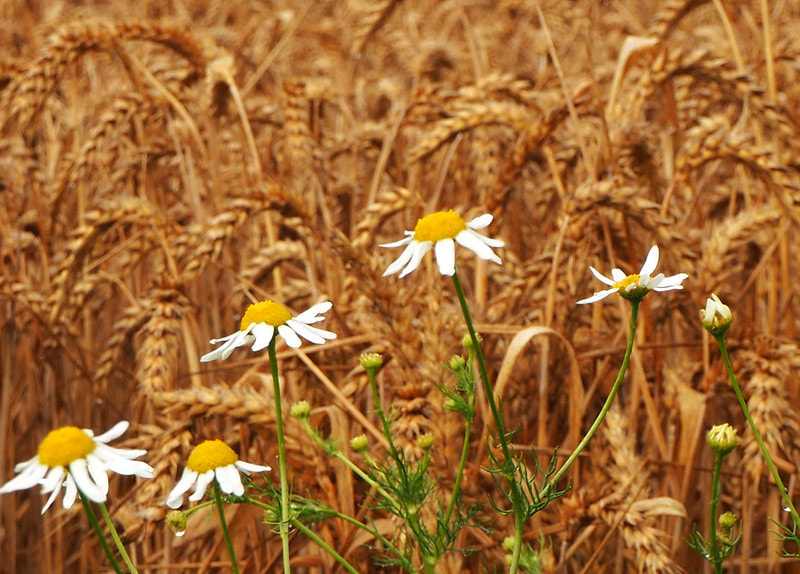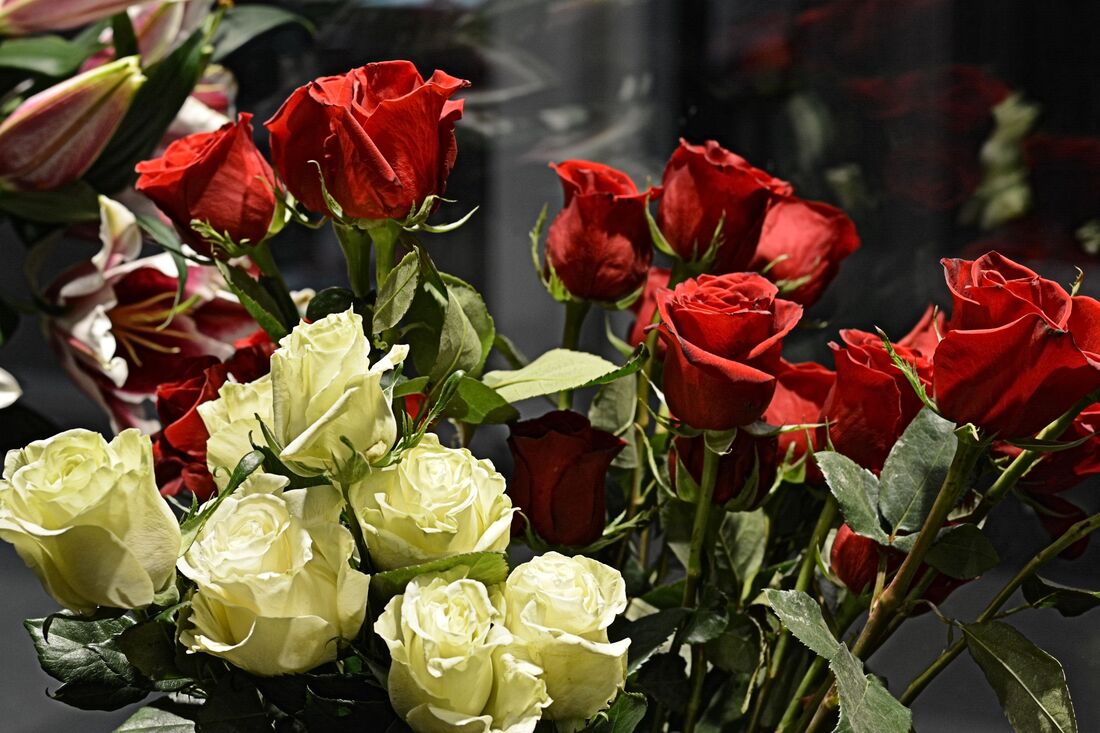|
The sunflower has a long history, with its first use being cultivated by tribes in North America around 4500 years ago.
Sunflowers were first discovered by European explorers in 1510. However, it wasn't until 200 years later that Europeans began to acknowledge the food and oil-bearing potential of sunflower seeds. It was In Russia, the crop's potential for oil production was established. Beginning in the 1800's, a steady trickle of Eastern Europeans began to emigrate to North America. Among them were Russian settlers who brought with themselves sunflowers and used it as animal feed primarily due its high protein content. Thus, the sunflower had returned to its origins and has flourished ever since. The blossom of the sunflower is called a head and can actually contain up to 2,000 individual flowers! The petals we see on the outside are ray florets and disc florets develop in centers which contain seeds. The seeds of the sunflower are rich in nutrients and can be used as a snack for people or birds. They grow inside the center part of the flower. The sunflower is a diverse and fascinating flower with many different characteristics. The tallest species of the Helianthus genus can only grow up to 9 feet, but there are also dwarf varieties that reach 8 inches at maturity. Sunflowers vary in color as well; their petals range from yellow through orange, purple or red depending on genetics and environmental factors such as sunlight exposure. Sunflowers don't just follow the sun, they track it. The French word for "sunflower" is tournesol which means turns with the sun. Young sunflowers will face east and follow the Sun during day but as soon as night comes their heads turn west to appreciate a beautiful sunset! As a flower grows its head becomes heavier. As they mature, they point themselves eastward all throughout the day. Sunflowers are great for summertime bouquets and arrangements. Their cheery presence can last a long time in an arrangement, if they're cut properly and conditioned or hydrated. Cut at a 45-degree angle and allow to condition in hot or warm water. Allow sunflower stems to take up the water this way for at least 24 hours if possible. Try to keep them out of direct sunlight at this point. You can keep them in bright light, but not direct light. And avoid drafts or high air flow areas. This will dry the flowers out. We recommend refreshing the water daily and using hot or warm water is best. You can add flower or plant food at that time if desired. You should be able to enjoy your sunflowers indoors for 10 days or more, following these suggestions above. DaisiesDaisies are the perfect flowers for delivering warm smiles to those we love most. They're bursting with vibrant colors and a welcoming spirit that's cherished by people all around the world, from North America to China! With over 150 different types of daisy species in existence today, it doesn't get any more diverse than this flower family.
Daisies have become an iconic symbol throughout our culture- they stand as symbols of wealth or purity; their petals represent both life’s beauty and impermanence; but mostly they serve as one of nature’s sweet reminders about how loved you really are at home, work or anywhere else on earth. Daisies are a very common flower, and because of this they have many uses. They can be used as decorations for special occasions like weddings or funerals; you can use them to make crowns, bouquets, corsages or boutonnieres (to wear on your lapel); you could also just pick some daisy flowers in the park if you feel homesick! With their long colorful petals bursting like rays of sunlight, Daisies are the perfect bloom with which to deliver warm smiles that say “I love You.” Daises belong To one Of Earth's biggest plant families; Vascular plants. But where did they begin? The daisy has had a long lineage dating back to 2200 BC and the ancient Egyptians. They grew these flowers in their gardens and used them for medicinal purposes. The daisy is named after the Old English phrase "daes eage," or day's eye, because of how it blooms at dawn. The Gerbera, the most well-known daisy variety in the modern world, was discovered by a Scottish man named Robert Jameson. In 1890 it traveled to England where breeders grew brighter and sturdier varieties of Gerberas that became popular among flower enthusiasts around Europe due to their beauty and appeal. The Netherlands quickly became one of the biggest distributors for these beautiful flowers because they were able to cultivate them so successfully. The Gerbera daisy is a flower that comes in every color of the rainbow, brightening up any occasion. The petals on this cheerful bloom make it perfect for birthdays and weddings alike! But there are a couple of other types of daisies worth mentioning! The Shasta daisy is an iconic, easy-to-grow perennial that can be enjoyed year after year. With its large and soft white petals radiating from a golden center, these plants are perfect for sunny gardens or borders in wooded areas. The Rudbeckia, also commonly called Black-Eye Susan, is a popular choice for gardeners because of its low-maintenance qualities and long lasting blooms. Its yellow petals are the perfect complement to deep brown centers that resemble miniature sunflowers, which makes it an excellent addition to any flower bed or bouquet. The fiery yellows on this plant are very striking! These big, bold flowers have been known as easy-care plants with staying power in gardens —making these some of the top picks for gardeners everywhere. Roses are a plant that is native to the temperate regions of the Northern Hemisphere, where many people cultivate it for its beautiful flowers. These plants range in colour from white through various yellow, pink, dark crimson and maroon colours.
Roses are among the most common types within the rose family (Rosaceae) because they consist of an estimated 100 species, which can be found mainly around North America's temperate region. They are often cultivated by locals who have discovered their beauty. Though it is challenging to determine the basic species of roses, they are native almost exclusively in Asia. The rose varieties today from North America and Europe may have originated when different Asian types were crossbred by humans long ago. Since then, most hybridization has taken place among these few original plants, giving rise to the many hybrids we see now. Roses have a long and colourful history. They started out as symbols of love, beauty, war, and politics. With the newfound evidence that they are 35 million years old, they could be considered ancient! There is only one genus Rosa with 150 species spread all around the Northern hemisphere from Alaska to Mexico to northern Africa! Roses have been used as a symbol of love and beauty since ancient times. The Romans began cultivating roses back in the first century during their rule over what is now modern-day Europe. In Ancient Rome, they were most commonly grown for medicinal purposes, yet they may have had other uses such as decoration at weddings, celebrations, or even thrown around like confetti! During the fifteenth century, England was in a state of civil war. The two factions vying for control were York and Lancaster. To identify themselves on battlefields or during various raids and attacks, they used symbols to show their allegiance, which eventually became known as "the War of the Roses." During the medieval era, English society was rife with violence between rival clans fighting for power over one another - it all started when someone decided that white roses would be an appropriate representation of those loyal to King Edward IV while red rose emblems would signify supporters from Richard III's camp. In the seventeenth century, roses were in such high demand that they could be used as legal tender for transactions. When Napoleon's wife Josephine established an extensive collection of flowers at Chateau de Malmaison near Paris during the 1800s, she and her successors collected many different flowers to add to this legacy. It wasn't until the late eighteenth century that rose cultivars from China were introduced to Europe. This introduction was a major breakthrough for hybridizers, as it opened up opportunities to breed roses with hardiness and an extended bloom season. The introduction of cultivated Chinese species by way of European traders made these flowers very popular in their time, paving the way for future breeding work on native breeds. This type of breeding had been neglected at this point in history due mainly to lack of interest or available resources. Roses are delightful additions to any garden. They can brighten up a dull day and add life and beauty to your surroundings. However, before you invest in these beautiful flowers, you must do your research so they're properly cared for. Look into the proper soil type, water needs and sunlight exposure requirements of each variety, and other factors like insects, pests, or disease susceptibilities specific to certain varieties that could affect their longevity. |
Archives |



 RSS Feed
RSS Feed
